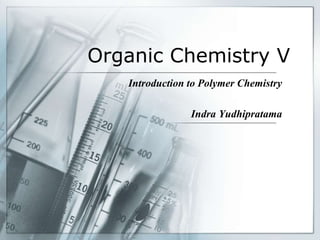
Introduction to Polymer Chemistry
- 1. Organic Chemistry V Introduction to Polymer Chemistry Indra Yudhipratama
- 2. Outline Defining the terms in polymer Type of polymers Polymer synthesis (Polymerisation) and the properties of its product Addition polymerisation Polyalkenes Condensation polymerisation Polyesters Polyamides Enhancing the polymers
- 3. Introduction Polymers in daily life All of those are synthetic polymers. Mother nature also produces polymers.
- 4. Defining Polymer Polymers Poly (many) + mer (unit) Hence polymer is a macromolecule that is built from smaller unit (monomer) Proteins are built from many amino acids. Proteins are polymers, amino acids are the monomers A polymer can be built from the same monomer Homopolymer e.g. Poly(tetrafluoroethene) Also can be built from different monomers Copolymer e.g. ABS (Acrylonitrile-Butadiene-Styrene)
- 6. Polymerisation Addition polymerisation Involving radicals chemistry Three main steps: Initiation An initiator is required to start reaction Propagation The chain is propagated to form a long chain Termination Reacts with another radical species to stop the reaction
- 7. Addition Polymerisation E.g. Synthesis of Poly(chloroethene) or PVC Initiation step Propagation step Termination step
- 9. Addition Polymerisation The product of addition polymerisation From alkene alkane, hence stronger in structure. More rigid/solid structure The products could have different arrangement: Regular structure provides rigid, tough, heat resistant polymers. Known as Isotactic Commonly used for food containers, hospital equipments.
- 10. Addition Polymerisation The product could have different arrangement: Irregular structure provides more flexible and softer polymers. Known as atactic. Used as sealants and coatings. Third type, the functional group alternates between one side and others, known as syndiotactic. This also has regular structure.
- 11. Condensation Polymerisation Producing small molecules as side products. Commonly water is the small molecules, hence the process known as condensation. Polyester formation Difunctional groups are required to form condensation polymers. Dicarboxylic acids with diols to form polyesters
- 12. Polyesters Polyesters in daily life Poly(ethylene terephtalate) or known as PET. The monomers are phtalic acid and ethane-1,2-diol. A rigid structure due to benzene rings. Used as plastic bottle
- 13. Polyamides Has amide linkage, occur in nature e.g. proteins. Formed from amino acids Synthesised in laboratory from diacyl chlorides and diamines Problem in synthesis with dicarboxylic acids and diamines
- 14. Polyamides Polyamides in daily life Nylon Two types of nylon: Nylon-6 Synthesised from caprolactam
- 15. Polyamides Two types of nylon: Nylon-6,6 Synthesised from hexane-1,6-dioic acid and 1,6-diaminohexane Long alkyl chain gives the flexibility of nylon. Strong structure of polyamides due to hydrogen bonding and amide bonds No strong hydrogen bonding in polyesters
- 16. Enhancing the Polymers’ Properties Some polymers are synthesised to meet the market requirements. Properties of polymers determine its function on the market Example: Hardness, hydrophilicity Changing the monomers would change the properties of polymers Some methods to change the hardness of the polymers: Using cross-linker Shortening the monomer chain Using the aromatic functional group
- 17. Enhancing the Polymers’ Properties Forming crosslink Natural rubber (rubber band) vs Tyres Both of them are poly(isoprene) Tyres manufacturing using sulphur as cross-linker Vulcanisation process Bind different polymer chains covalently
- 18. Enhancing the Polymers Vulcanisation process Sulphur as cross-linker The covalent bonds of sulphur keeps the shape
- 19. Enhancing the Polymers Forming crosslink Manipulating the monomers Difunctional monomers are used Case of contact lenses Can be polymerised at both ends Forming polymer networks hydrogels
- 20. Enhancing the Polymers Shortening the monomers Case of pacemaker (polyurethanes) Polyurethanes are copolymer Consists of different monomers Shorter chain (blue) gives the rigidity while the longer chain (red) gives the flexibility over the pacemaker The flexibility over sp3 carbon chain (free rotation)
- 21. Enhancing the Polymers Using aromatic functional group Case of Nylon vs Kevlar The planar structure of benzene ring causes the polymer can be packed more closely. Increase rigidity of the polymer
- 22. Inorganic Polymers Non-carbon based polymers can also be synthesised Silicone Si-based polymers PDMS Poly(dimethylsiloxane) Hydrophobic liquid polymer with highly flexible chains Widely used in shampoo formulation Known as dimethicone
- 23. Inorganic Polymers Silicone hybrid Used in contact lenses Combined with carbon-based polymers
Editor's Notes
- Need pictures
